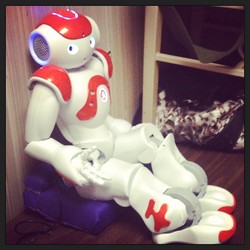Thus far, NAO and other humanoid robots are commonly used successfully to help teach children STEM subjects, as well as help children with autism learn social skills. But there is one education program using NAO in a completely different way - and with some very promising results.
Dr. Ellie Kazemi is a behavior analyst who is using NAO in a very unique way. She is currently a Professor of Psychology and the Academic Director of the Masters of Science in Applied Behavior Analysis Program at California State University, Northridge (CSUN.) For her research, she and her students are using NAO to simulate a child with problem behavior in order to find helpful strategies in training caregivers (staff, teachers, etc.) how to deal with problem behavior.
Dr. Kazemi has been able to secure some research and training funds to purchase three NAOs, warranties, and licenses to engage research assistants in science and technology. The funds were provided through the College of Social and Behavioral Sciences and the National Institute of Health-Build Poder.
Programming NAO to display undesirable behavior (i.e., to be “bad”) and then running simulations helps the students learn in hands-on labs. The team has the robot throw tantrums, hit himself, and more - even programming in variations so he looks and acts a little different in each simulation. This gives them a lot of control in the types of behavior the person they are training gets to see.

Dr. Kazemi has been doing this line of research for roughly three years, and prior to using NAO, she used human actors who were following a script.
“On one level, it is extremely exciting to use advanced technology. The feedback I get from participants is when they come into the study, they believe a robot as a simulated client would be very unlikely to be helpful. They leave the research with a completely different opinion - rating him very high. That says a lot.”
But how does NAO actually compare to a live actor? This was the purpose of a recent study published by Dr. Kazemi and one of her graduate students, Lisa Stedman-Falls. In the study, they note that the effects are very similar - people being trained learned similarly across both simulation types. Of course, more research is needed to be conclusive, but thus far, there seems to be almost no difference between NAO and an actor, which helps to establish NAO as a simulated client for other uses.
Another positive aspect Dr. Kazemi has noticed is the research assistants’ understanding of behavior is accelerated. While it’s one thing to study and talk about the definitions of behavior, it’s another to know it so well that you can program it. Working to program behavior really tests a student’s and teacher’s skills and understanding of the behavior.
“You think you know what a tantrum looks like when your profession is to deal with them. We all have these hypotheses on what they look like, but then we end up having to watch hours and hours of video to see what really makes that tantrum real.”
 This in-depth study has opened Dr. Kazemi and her students up to understanding just how much they still have to learn about problem behavior in order to properly program the NAO.
This in-depth study has opened Dr. Kazemi and her students up to understanding just how much they still have to learn about problem behavior in order to properly program the NAO.
However, running simulations with a robot does not always go smoothly. Dr. Kazemi notes that NAO does not always run the same program the same way, which does cause some disruption in the training from time to time.
Currently, most of the programs and uses for NAO revolve around teaching children (in and out of the classroom), and even helping special needs children in learning, socialization, and more. By using the NAO as a simulated child, Dr. Kazemi’s work flips the narrative and social attention of the robot. However, it does pose a problem in finding and tailoring programs for the NAO that will work for her purposes. It will be interesting to see how these areas can evolve as more and more use NAO for different purposes.
Dr. Kazemi also mentions that the work her team has done, the expertise they’ve gained, and the grant support they’ve gotten would not have been possible without the help of Elad and RobotLab. “He taught us on small budgets when we initiated the project, and has been such a strong supporter.” And the support is ongoing - from providing Dr. Kazemi with links to relevant research to jumping in and helping when a problem with the robot occurs.
To see Dr. Kazemi’s research site with some descriptions of her work with NAO, visit http://klab-csun.weebly.com/simulators-in-behavior-analysis.html.
Curious to see how NAO could be used in your classroom or district? RobotLAB would love to help! Click to request a free phone/Skype consultation.

